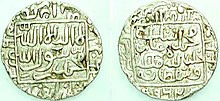| Revision as of 15:20, 14 August 2005 view source212.138.47.13 (talk) →External links← Previous edit | Revision as of 15:25, 14 August 2005 view source 212.138.47.15 (talk) editNext edit → | ||
| Line 1: | Line 1: | ||
| ] | ] | ||
| The '''Rohingya''' are a minority ] ] in Northern ], Western ]. The Rohingya population is mostly concentrated in three northern townships of ] (formerly known as ]) |
The '''Rohingya''' are a minority ] ] in Northern ], Western ]. The Rohingya population is mostly concentrated in three northern townships of ] (formerly known as ]) | ||
| ==History== | ==History== | ||
Revision as of 15:25, 14 August 2005
The Rohingya are a minority Muslim ethnic group in Northern Rakhine State, Western Myanmar. The Rohingya population is mostly concentrated in three northern townships of Rakhine State (formerly known as Arakan)
History
The origin of the Rohingya is the subject of much dispute. The Rohingya claim that they are the true natives of Arakan, having converted to Islam centuries ago. The region was visited by Arab traders since ancient times, and cultural traits tend to support the Rohingyas being part of the native population of the region. However, some sections of the Burmese government claim that Rohingyas are migrants from regions in neighboring Bangladesh.
The Rohingya were formerly the majority community in Arakan. In the 1940s, and especially immediately after Burmese independence in 1948, increasing tensions between the Arakanese Buddhist Magh and the Muslim Rohingya resulted in the exodus of a large number of Rohingyas to Chittagong in Bangladesh. The Burmese government claimed that the Rohingya were relatively recent migrants from Bengal, and, therefore, did not include them among the indigenous groups qualifying for citizenship under the Burmese constitution. The U Nu regime let loose a reign of terror on the Rohingyas accusing them of having questionable nationality. Subsequent waves of hundred of thousands of Rohingya refugees indundated Bangladesh in the 1960s, 1980s, and 1990s, sparking major international crises.
Major incidents of repression on the Rohingya community occurred in 1942, 1962, 1978, and 1991. In 1991, following a crackdown on Rohingyas, 250,000 refugees took shelter in the Cox's Bazar district of neighboring Bangladesh. Although some were later repatriated, many were still left in refugee camps. It is estimated that, since Burmese independence in 1948, approximately one and a half million Rohingya are in exile. These exiles mostly live in Bangladesh, Pakistan, and Saudi Arabia, although a smaller number are also in the UAE, Thailand, and Malaysia. As of 2005, the UNHCR has been assisting with the repatriation of Rohingya from Bangladesh, but allegations of human rights abuses in the refugee camps has threatened this repatriation effort.
Rohingya activists claim that the Burmese government's objective is to turn Muslim Arakan into a Burmanised Buddhist region by reducing the Muslims to an insignificant or manageable minority, and that as a result, more than a quarter of the total area of arable land has been reduced to jungle. The government has started a massive reclamation of these confiscated Muslim lands for settlement of Rakhine Buddhists from both inside and outside Arakan. It is alleged that, the construction of pagodas and monasteries is currently taking place, particularly on the site of demolished Islamic structures, in order to change the face of Arakan and give it a Buddhist appearance.
Culture

Although classified as "Bengali Muslims" by the Myanmar government and denied recognition as an official ethnic group, the Rohingya have a distinct language and culture.
The Rohingya language is an eastern Indic language of the Indo-European family. The language has many borrowings from Urdu, Hindi, Bangla, and Arabic, although some words from Bamar and English are also included. The language used to be written using the Arabic script. However, there has recently been an effort to write it using the Roman script, the result being called Rohingyalish.
Religion is particularly important to the Rohingya people, who are predominantly Muslim. There are mosques and religious schools in every quarter and village. Traditionally, the men pray in congregation, while women pray at home. It is common for elderly Rohingya men to grow beards, and for women to wear the hijab.
See also
External links
- Free Rohingya Campaign— (Power on Blogger)
- Rohingya Times
- Website on Rohingya Language
- Rohingya News — In Burmese + English
- Arakanese portal
- Arakan Rohingya National Organization
- Kaladanpress Network
References
- "Rohingya". Banglapedia, Asiatic Society of Bangladesh. June.
{{cite web}}: Check date values in:|date=and|year=/|date=mismatch (help) - "A Short History of Arakan". Mohammed Ashraful Alam. June.
{{cite web}}: Check date values in:|date=and|year=/|date=mismatch (help) - "Myanmar, The Rohingya Minority: Fundamental Rights Denied". Amnesty International. August.
{{cite web}}: Check date values in:|date=and|year=/|date=mismatch (help)